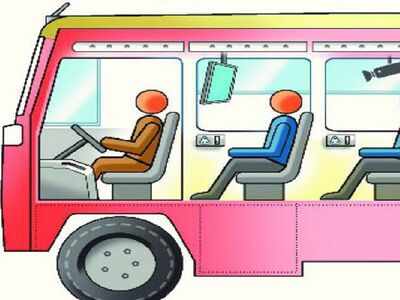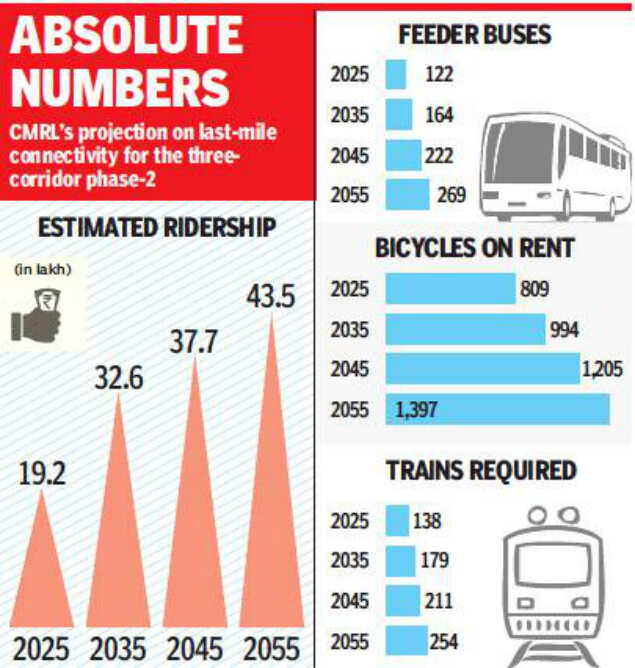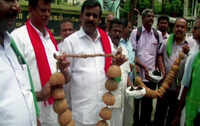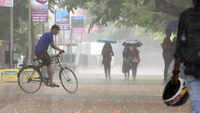
CHENNAI: When Chennai Metro Rail Limited (CMRL) begins its operations on the first leg of the 118.9km phase-2 by 2025 with more than 130 trains, it would need 122 feeder buses and more than 800 bicycles to provide last-mile connectivity and attract commuters.

In three decades, CMRL has projected double those numbers — 269 feeder buses and 1397 bicycles on rent by 2055 — to provide an efficient intermodal transport system. Providing last-mile connectivity is vital if CMRL intends to achieve a majority of its projected daily ridership of 19.2 lakh by 2025.
CMRL is likely to begin construction for a 52km ‘priority’ corridor from Madhavaram to Sholinganallur and CMBT by early next year. The line is expected to be ready by 2024-'25. Simultaneously, the construction of the other stretches is also likely to begin.
At present, of the 32 stations, MTC small buses are being operated as feeders from 16 stations including CMBT, Vadapalani, Guindy and Central. CMRL also operates share autos and taxis in 13 stations. However, a few of the newly opened stations between Washermenpet and AG-DMS do not provide connectivity.
In the 45km phase-1, CMRL touched one lakh daily ridership three years after it began its operations. However, it was only 13% of the estimated ridership. Though the services touched one lakh a day in April, the ridership dropped again, and commuters blamed it on the lack of connectivity.
“We received a good response on the share auto and taxi services we began last year. We will extend the service to all 32 stations in August,” said a metro rail official.
Experts have observed that the current feeder service enables users to reach their destinations from the stations but is not convenient for those who want to reach the station from their location. “Small buses and more share autos at frequent intervals should be introduced to encourage people to use the metro. With the metro in operation for 4 years, a good system of frequent feeder service is pivotal to ensure ridership increases 10 times to reach the phase-1 target of seven lakh,” said Nashwa Naushad, senior associate, ITDP.
She said, “In order to expand feeder services, a study should be conducted to understand how users access the station now. Investments in creating parking lots can then be diverted towards improving feeder services since the former would serve a very small percentage of people and would contribute to less than 2% of the targeted ridership.”

In three decades, CMRL has projected double those numbers — 269 feeder buses and 1397 bicycles on rent by 2055 — to provide an efficient intermodal transport system. Providing last-mile connectivity is vital if CMRL intends to achieve a majority of its projected daily ridership of 19.2 lakh by 2025.
CMRL is likely to begin construction for a 52km ‘priority’ corridor from Madhavaram to Sholinganallur and CMBT by early next year. The line is expected to be ready by 2024-'25. Simultaneously, the construction of the other stretches is also likely to begin.
At present, of the 32 stations, MTC small buses are being operated as feeders from 16 stations including CMBT, Vadapalani, Guindy and Central. CMRL also operates share autos and taxis in 13 stations. However, a few of the newly opened stations between Washermenpet and AG-DMS do not provide connectivity.
In the 45km phase-1, CMRL touched one lakh daily ridership three years after it began its operations. However, it was only 13% of the estimated ridership. Though the services touched one lakh a day in April, the ridership dropped again, and commuters blamed it on the lack of connectivity.
“We received a good response on the share auto and taxi services we began last year. We will extend the service to all 32 stations in August,” said a metro rail official.
Experts have observed that the current feeder service enables users to reach their destinations from the stations but is not convenient for those who want to reach the station from their location. “Small buses and more share autos at frequent intervals should be introduced to encourage people to use the metro. With the metro in operation for 4 years, a good system of frequent feeder service is pivotal to ensure ridership increases 10 times to reach the phase-1 target of seven lakh,” said Nashwa Naushad, senior associate, ITDP.
She said, “In order to expand feeder services, a study should be conducted to understand how users access the station now. Investments in creating parking lots can then be diverted towards improving feeder services since the former would serve a very small percentage of people and would contribute to less than 2% of the targeted ridership.”
World Cup 2019
Trending Topics
LATEST VIDEOS
More from TOI
Navbharat Times
Featured Today in Travel
Quick Links
Lok Sabha Election Schedule 2019Lok Sabha Election NewsDelhi Capitals teamMI team 2019Rajasthan Royals 2019RCB team 2019Maharashtra Lok Sabha ConstituenciesBJP Candidate ListBJP List 2019 TamilnaduShiv Sena List 2019AP BJP List 2019Mamata BanerjeeBJP List 2019 MaharashtraPriyanka GandhiBJP List 2019 KarnatakaAMMK Candidate List 2019BJP List 2019 WBLok Sabha Elections in Tamil NaduBSP List 2019 UPNews in TamilLok Sabha Poll 2019Satta Matka 2018PM ModiMahagathbandhanNagpur BJP Candidate ListChandrababu NaiduTamil Nadu ElectionsUrmila MatondkarNews in TeluguMadras High CourtTejashwi YadavArvind KejriwalTejasvi SuryaPawan KalyanArvind KejriwalYogi AdityanathJaya PradaSatta King 2019Srinagar encounter
Get the app









